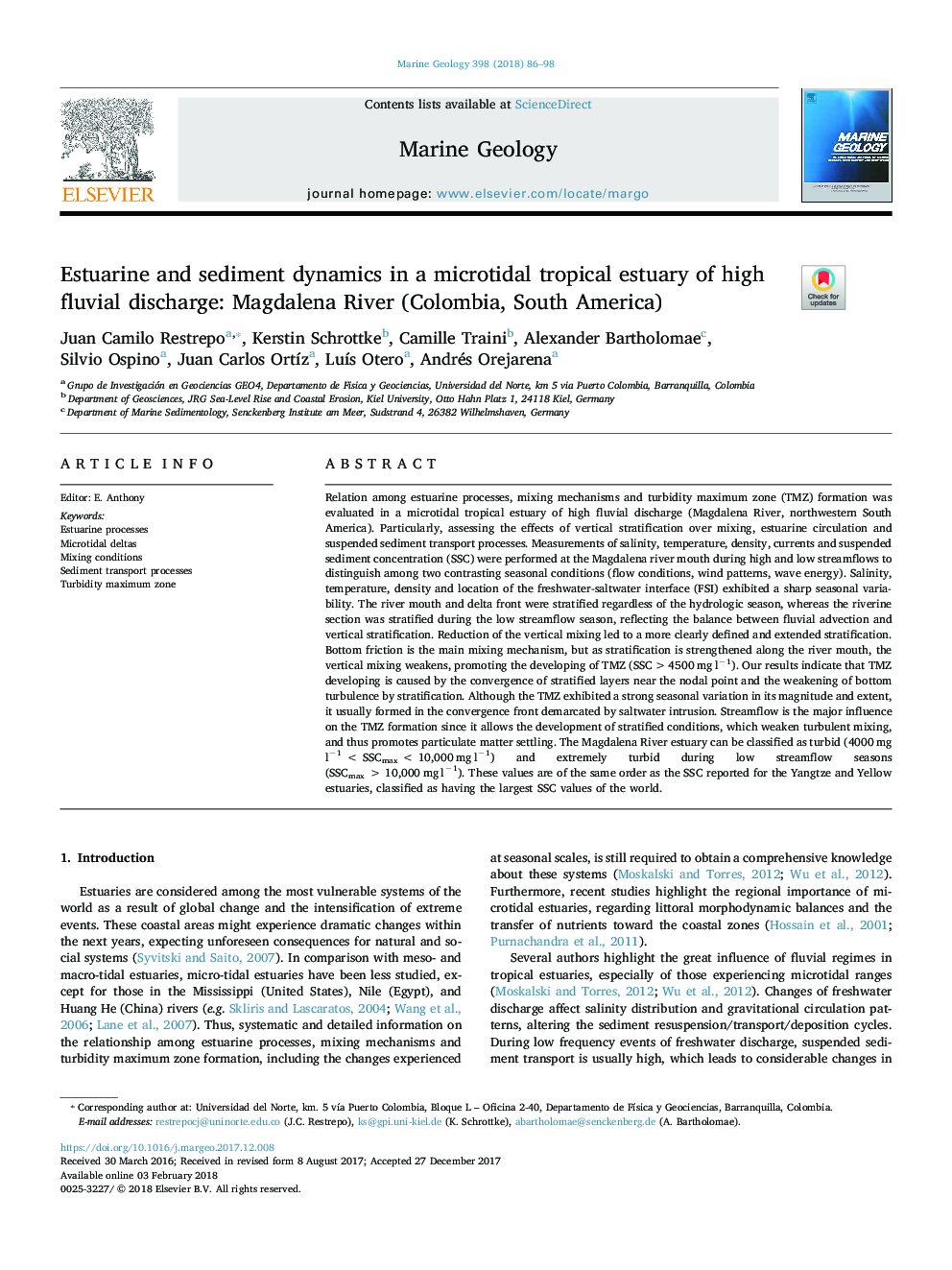| کد مقاله | کد نشریه | سال انتشار | مقاله انگلیسی | نسخه تمام متن |
|---|---|---|---|---|
| 8912001 | 1639054 | 2018 | 13 صفحه PDF | دانلود رایگان |
عنوان انگلیسی مقاله ISI
Estuarine and sediment dynamics in a microtidal tropical estuary of high fluvial discharge: Magdalena River (Colombia, South America)
ترجمه فارسی عنوان
دشت های رسوبی و رسوب در یک رگبار گرمسیری ریزماهواره ای از تخلیه رگبار بالا: رود مگدالنا (کلمبیا، آمریکای جنوبی)
دانلود مقاله + سفارش ترجمه
دانلود مقاله ISI انگلیسی
رایگان برای ایرانیان
کلمات کلیدی
فرآیندهای مصطفی، دلتای میکروتیال، شرایط مخلوط کردن، فرآیندهای حمل و نقل رسوب، بیشترین زبر بودن منطقه،
موضوعات مرتبط
مهندسی و علوم پایه
علوم زمین و سیارات
ژئوشیمی و پترولوژی
چکیده انگلیسی
Relation among estuarine processes, mixing mechanisms and turbidity maximum zone (TMZ) formation was evaluated in a microtidal tropical estuary of high fluvial discharge (Magdalena River, northwestern South America). Particularly, assessing the effects of vertical stratification over mixing, estuarine circulation and suspended sediment transport processes. Measurements of salinity, temperature, density, currents and suspended sediment concentration (SSC) were performed at the Magdalena river mouth during high and low streamflows to distinguish among two contrasting seasonal conditions (flow conditions, wind patterns, wave energy). Salinity, temperature, density and location of the freshwater-saltwater interface (FSI) exhibited a sharp seasonal variability. The river mouth and delta front were stratified regardless of the hydrologic season, whereas the riverine section was stratified during the low streamflow season, reflecting the balance between fluvial advection and vertical stratification. Reduction of the vertical mixing led to a more clearly defined and extended stratification. Bottom friction is the main mixing mechanism, but as stratification is strengthened along the river mouth, the vertical mixing weakens, promoting the developing of TMZ (SSC >4500â¯mgâ¯lâ1). Our results indicate that TMZ developing is caused by the convergence of stratified layers near the nodal point and the weakening of bottom turbulence by stratification. Although the TMZ exhibited a strong seasonal variation in its magnitude and extent, it usually formed in the convergence front demarcated by saltwater intrusion. Streamflow is the major influence on the TMZ formation since it allows the development of stratified conditions, which weaken turbulent mixing, and thus promotes particulate matter settling. The Magdalena River estuary can be classified as turbid (4000â¯mg lâ1â¯<â¯SSCmaxâ¯<â¯10,000â¯mgâ¯lâ1) and extremely turbid during low streamflow seasons (SSCmaxâ¯>â¯10,000â¯mgâ¯lâ1). These values are of the same order as the SSC reported for the Yangtze and Yellow estuaries, classified as having the largest SSC values of the world.
ناشر
Database: Elsevier - ScienceDirect (ساینس دایرکت)
Journal: Marine Geology - Volume 398, 1 April 2018, Pages 86-98
Journal: Marine Geology - Volume 398, 1 April 2018, Pages 86-98
نویسندگان
Juan Camilo Restrepo, Kerstin Schrottke, Camille Traini, Alexander Bartholomae, Silvio Ospino, Juan Carlos OrtÃz, LuÃs Otero, Andrés Orejarena,
